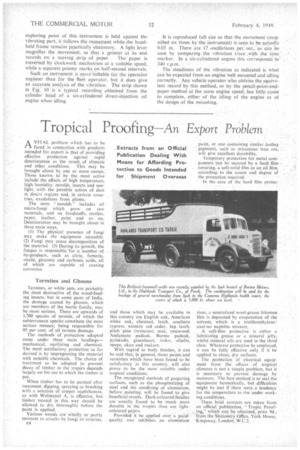Tropical Proofing—An Export Problem A VITAL problem which has to be
Page 12

If you've noticed an error in this article please click here to report it so we can fix it.
faced in c.onnectiOn„ with .products intended for export is that of providing effective protection against rapid deterioration as the resulLof climatic and other conditions: 'This ma Y be brought about by one or more catises; Those known, to be the . most active include the effects of high temperature, high humidity. moulds, insect S and sunlight, with the Possible action of dust in desert regions and, in certain countries, exudations from plants.
The term moulds" includes all micro-fungi which grow on raw materials, and on foodstuffs, textiles, paper. leather, paint and so on. Deterioration may he brought about in three main ways. .
(1) The physical presence of fungi may make the equipment unusable. (2) Fungi may cause decomposition of the material. (3) During its growth, the fungus is.respOnsible:for :a number of by-products, such as citric, fumaric, oxalic, gluconic and carbonic acids, all of which are capable of causing corrosion: •
Termites and Ghoons
Termites, or white ants, are probably the most destructive of the wood-feeding insects, but in some parts of India, the damage caused by ghoons, which are members of the beetle family, may be more serious. There are upwards of 1,700 species of termite, of which the subterranean species constitute the-most serious menace, being responsible for 95 per cent, of all termite damage.
The methods of protection adopted come under three main headings— mechanical, sterilizing and chemical. The most satisfactory protection so far devised is by impregnating the material with suitable chemicals. The choice of treatment to be adopted to prevent decay of timber in the tropics depends largely on the use to which the timber is put. •
When timber has to be painted after treatment, dipping, spraying or brushing with a solution of copper naphthenate, or with Wolmanol• A, is effective, but timber treated in this way should be allowed to dry thoroughly before the paint is applied.
Various woods are wholly or partly resistant to attacks by fungi or termites, c4 and those which may be available in this country are English oak, American white oak, chestnut, larch, southern cypress,' western red cedar, Iap larch, pitch pine (resinous), teak, rosewood. Andamans padauk, . Burma padauk, py i nka do, green heart, iroko, afz,e1 ia , opepe, okan and makare..
With. regardto body finishes, it can be said that, in general, those paints and varnishes which have been found to be satisfactory in this country, will also prove to be the moSt suitable under tropical conditions.
The recognized methods of preparing surfaces, such as -the phosphatizing of steel and the anodizing of aluminium, before painting, will be found to give beneficial results. Dark-coloured finishes are usually found to be much more durable in the tropics than are light coloured paints. ' Provided it be applied Over a gobel: quality rust inhibitor, an aluminium paint, or one containing similar :leafing pigments, such as micaceous iron ore, will give excellent durability.
Temporary protection for metal components 'can be secured by a hard film covering, a soft-solid film or an oil film, according to the extent and degree of the protection required.
In the_case of the hard film protee .
lives, a neutralized wool-grease bitumen film is deposited by evaporation of the solvent, which is a trichlorethylene/ coal-tar naphtha mixture. A soft-film protective is either a lubricating grease or a mineral jelly, whilst mineral oils are used in the third class. Whatever protective be employed, it can be fully effective only if it be applied to clean, dry surfaces.
The protection of electrical equipment from the effects of tropical climates is not a simple problem, but it is necessary to prevent damage by moisture. The best method is to seat the equipment hermetically, but difficulties Might be met if there were a tendency for the temperature to rise under working conditions.
These brief extracts are taken from an official publication, " Tropic Proofing," which can be -Obtained, price 9d., frOin the Stationery Office, York House,
Kinesway, London, W.C.2. •


























